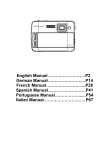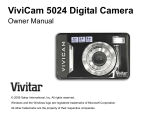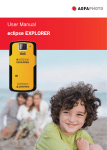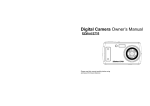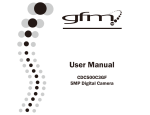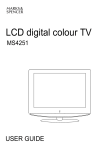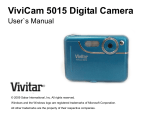Download Vivitar ViviCam 5022 User`s manual
Transcript
ViviCam 5022 Digital Camera User‟s Manual © 2009 Sakar International, Inc. All rights reserved. Windows and the Windows logo are registered trademarks of Microsoft Corporation. All other trademarks are the property of their respective companies. Table of Contents Introduction ..................................................................................................................................................... 2 Key Features ................................................................................................................................................... 2 What your camera includes ............................................................................................................................. 2 Computer System Requirements for Windows XP ........................................................................................... 3 Computer System Requirements for Windows Vista ........................................................................................ 3 Computer System Requirements for Macintosh ............................................................................................... 4 A Quick Look at Your Camera.......................................................................................................................... 4 Preparing Your Camera for Use ....................................................................................................................... 5 Installing SD Memory Card .............................................................................................................................. 6 Starting Your Camera ...................................................................................................................................... 8 Camera Modes................................................................................................................................................ 8 Install the Vivitar Experience Image Manager Software ................................................................................. 19 Connect your camera to the computer ........................................................................................................... 22 Get photos and videos from your camera to your computer ........................................................................... 22 Get started! ................................................................................................................................................... 23 Transfer media from my camera to my computer manually (Using Windows) ................................................ 24 Transfer media from my camera to my computer manually (Using Macintosh) .............................................. 24 Maintenance of Your Digital Camera ............................................................................................................. 25 Sakar Warranty Card ..................................................................................................................................... 25 Appendix A: Specifications ............................................................................................................................ 27 Appendix B: Troubleshooting ......................................................................................................................... 27 1 Introduction Thank you for purchasing the ViviCam 5022 5.1 Mega-Pixel Digital Camera. Everything you need to take quality digital photos and videos is included with your camera. Your digital camera can also be used as a removable disk. It enriches your life. Please read this manual carefully first in order to get the most out of your digital camera. Key Features Digital Image Resolution- 5M, 3M, 2M, VGA. SD RAM 8MB. Supports SD/MMC memory card (not included) up to 8GB. 2.4 inch TFT Color LCD Vivitar Experience Image Manager software for uploading and managing photos and videos to or from the most popular photo sharing and social network websites. What your camera includes Digital Camera Vivitar Experience Image Manager software Installation CD USB cable Quick Start Guide Strap 2 Computer System Requirements for Windows XP To be able to download photos to your PC, you will need the following minimum configuration: Pentium 4 processor or above with Windows XP service pack 2 512 MB RAM, with 100MB of free disk space 1024 x 768 Recommended screen resolution 16-bit color or higher display adaptor CD-ROM Drive QuickTime 6 or higher Microsoft Internet Explorer 7 or higher Windows Media Player 10 or higher Internet connection required Computer System Requirements for Windows Vista To be able to download photos to your PC your will need the following minimum configuration: Windows Vista 800MHz processor and 512 MB of system memory 20GB hard driver with at least 15GB of available space Support for Super VGA graphics Available USB Interface CD-ROM drive QuickTime 6 or higher Microsoft Internet Explorer 7 or higher Internet connection required 3 Computer System Requirements for Macintosh Macintosh with Intel processor running Mac OS X v10.4.6 or later 256 MB RAM, 100 MB free disk space Display: 1024 x 768 or higher-resolution monitor QuickTime 6 or higher Internet connection required A Quick Look at Your Camera 4 Preparing Your Camera for Use Battery Installation Your camera requires 3 AAA batteries. To insert the batteries into the camera: 1. Slide and open the battery compartment at the bottom of the camera. 2. Please make sure that the batteries are inserted with the correct polarity facing up. 3. Close the battery door. When the “No Power” is displayed on the LCD, this indicates that your camera has an insufficient battery power level and will be automatically powered off. You need to download the sample photos and videos to your PC. If there is no SD card inserted before it powers off the photos and videos will be lost. 5 Note: 1. If you don‟t intend to use your camera for an extended period of time, please remove the batteries to avoid battery leakage and corrosion. 2. Please don‟t remove the batteries or power off your camera before downloading the test photos or videos when you have not inserted an SD card. The test images will be lost forever if they are not downloaded before the camera is shut down or powered off. 3. Do not mix old and new batteries. 4. We recommend you use Alkaline batteries. Do not mix alkaline, standard (carbon-zinc), or rechargeable (nickel-cadmium metal hydride) batteries. 5. In order to conserve battery power if the camera is on but not in use for 60 seconds it will automatically shut off. In this case too only the sample images will be lost. Installing SD Memory Card Your camera has a memory card slot that enables you to insert any “SD” compatible memory card. Adding a memory card is needed for normal use and will allow you to increase the capacity of your camera before you have to transfer photos and videos to your PC. Install the SD memory card as below: 1. Locate the Memory Card slot. 2. Insert the Memory card into the slot in the correct direction. (see the sketch below) 6 3. Push the card in until you feel it “click” into position. The top of the card should be flushed with the surface of the camera. An icon 4. will appear on the LCD screen after you turn on your camera. Once the external memory card is inserted into the camera all the images taken with the camera will be stored on the card. Note: 1. An external memory card is required for normal use. Your camera supports any compatible SD memory card (up to 8GB). 2. “Card inserted, change to card” will appear on the LCD screen when you insert the card indicating that photos and videos will now be stored on the SD memory card. Reversely, “Card removed, change to internal memory” will appear on the LCD screen when you remove the card. 3. If there are photos and videos in the internal memory when you insert the card into your camera, “copy SDRAM file to your card, please wait…” will appear on the screen. The media will now be copied to your card. 7 4. When you take out the SD memory card, “Card removed, change to Internal RAM” will appear on the LCD screen. With no card in the camera you will now only be able to take one test photo or 10 seconds of video. Starting Your Camera Press and hold the Power button to turn on your camera. The LCD screen will light up indicating that your camera is on and ready for use. To power off your camera, press and hold the Power button again for about 3 seconds. Camera Modes Taking photos Power on your camera, the default mode is Camera mode. A camera icon appears in the top left corner of the LCD screen. 1. Hold the camera steady and compose your object as appears in the LCD screen. 2. Press the Shutter button and wait a moment for the photo to be taken. Note: When the internal memory is full, the LCD screen will display “Memory Full! Insert a SD Memory Card to Transfer and Take More Photos!” If you attempt to take photos or videos when the camera‟s internal memory is full, the camera will beep continuously. Please download the test images to your computer using the Vivitar Experience Image Manager software as described below in the section “Transfer photos and videos 8 to your computer” as soon as possible or insert an SD memory card in order to take more images! Flash Your camera has a built in flash function which enables you to take photos when the light condition is not good. 1. Press the Up button. 2. The icon will appear at the top of the LCD indicating that the auto flash is turned on and ready to use. 3. Press the Up button again to change from the auto flash to the red eye function. 4. The icon will appear on the LCD indicating that the red eye reduction function has been activated. 5. Press the Up button once more until you see the icon appear on the LCD screen. This indicates that the flash is forced on. 6. To turn off the flash function, press the Up button again until the icon is displayed on the LCD. Note: A “Low Power” message will appear on the LCD screen, if you select the flash function when the battery power is insufficient. To continue using the camera with the flash, please install new batteries. Digital Zoom function You can magnify your subject using the digital zoom. Use the T and W buttons to adjust the zoom. 1. Press the T button to zoom in on your subject. 9 2. Press the W button to zoom back out. Change Image Resolution The default setting is 3M if no SD card is inserted. For higher resolution image changing please insert a SD memory card first. 1. Press the Menu/OK button. 2. Press the Up/Down button to select the RESOLUTION option. 3. Press the Menu/OK button. 4. Press the Up/Down button to select one of the following resolutions : (5M) 2592x1944 pixels (3M) 2048x1536 pixels (2M) 1920x1080 pixels (VGA) 640x480 pixels 5. Press the Menu/OK button again to confirm your selection. 6. The corresponding icon will appear on the top of the LCD screen. Note: 1. Different image resolutions will affect the photo quality. High resolution photos will be of better picture quality and therefore will take up more camera memory capacity than lower resolution photos. 10 Setting Photo Frequency The photo mode allows to you to set the frequency before capturing the photos. Different regions of the world require different light frequencies. To set the photo frequency: 1. Press the Menu/OK button. 2. Press the Up/Down button to select the FREQUENCY option. 3. Press the Menu/OK button again. 4. Press the Up/Down button to select either: 50 HZ 60 HZ 5. Press the Menu/OK button to confirm. Anti-shake function Your Digital Camera has a function that prevents photos coming out blurry as a result of trembling or shaking while the photo is being taken. This function allows you to take good quality photos even without the use of a tripod. To set this function: 1. Press the Menu/OK button. 2. Press the Up/Down button and select the Anti-shake option. 3. Press the Menu/OK button. 11 4. Use the Up/Down button to select either: “On” - to activate and turn the anti-shake on. “Off” - to leave or turn the anti-shake off. 5. Press the Menu/OK button to confirm. The Anti-shake icon appears on the top of the LCD screen. Language You can change the language setting on your Digital Camera 1. Press the Menu/OK button. 2. Press the Up/Down button and select the Language option. 3. Press the Menu/OK button. 4. Use the Up/Down button to select either: English, French, Portuguese or Spanish 5. Press the Menu/OK button to confirm and save your choice. The camera menus and interface now appear in the language that you selected. Macro/Far shooting The camera has the function that allows you to capture objects at very near (up to 80 cm) or very far distances per your request. 1. Slide the Macro/Far switch on the left side of the camera to the 2. The icon position. will appear on the LCD screen and indicates that the macro shooting is on. 12 3. For far shooting slide the Macro/Far switch to the 4. The icon position. appears on the LCD screen to indicate that the far shooting is on. The mountain setting gives you maximum depth-of-field you can possibly get with the lens you are using. You now can have the overhead branch in focus as well as the mountains in focus - and everything in between! Self Timer You can include yourself in a photo by using the Self Timer feature to delay the time between your pressing the shutter and when the photo is actually taken. It is recommended that you use a tripod or place the camera on a flat and secure surface when you use the self-timer. 1. Press the Down or Timer button. 2. The timer icon 3. Press the Shutter button. 4. The camera will begin to emit beeps and a 10 seconds countdown appears on the LCD accompanied by will now appear instead of the camera icon on the top left corner of the LCD. a flashing red LED light. 5. At the end of the 10 seconds the camera will automatically take the picture. 6. To use the Self Timer again simply press the Shutter button once more. 7. To exit the Self Timer mode press the Down or Timer button. 8. The Timer icon on the top left corner of the LCD will disappear and the camera icon will reappear indicating that the camera is set back to the Camera mode. 13 Self Timer shortcut button 1. You can activate the Self Timer by simply pressing the SelfTimer/ Down button. 2. The camera icon on the top left corner of the LCD will change to the Self Timer icon. 3. Position the camera. 4. Press the Shutter button and the 10 second self timer countdown will begin. Delete last photo quickly In camera mode, you can quickly delete the last photo you have taken: 1. Press the Right button. 2. A Delete File message will appear on the LCD with a Yes or No option. The No option is selected by default. 3. Press the Left button to choose the „Yes‟ option (this will be underscored) or press the right button to move back to the „No‟ option if you decide not to delete. 4. Press the Menu/OK button to confirm. Video Mode The Video Mode allows you to shoot high quality AVI movies. In order to use this mode an SD card needs to be inserted into the camera. 14 1. Insert a compatible SD memory card. 2. Power on your camera. 3. Press the MODE button. 4. The Video icon 5. Press the Shutter button to start shooting the video. The elapsed time appears on the bottom right corner now appears in the top left corner of the LCD. of the LCD. 6. Press the Shutter button to stop the recording. The video will be saved as an AVI file on the memory card. Note: 1. “Insert an SD Memory Card” will appear on the LCD screen as soon as you enter the Video mode. 2. You can playback the AVI file by using Quick Time or Windows Media Player once it has been downloaded to your computer. Setting Video Resolution The video mode allows to you to set the resolution size before capturing the video. The higher the resolution, the better the quality of the video taken. Recording time for higher resolutions is less than for lower resolution. To set the video resolution: 1. Press the Menu/OK button. 2. Press the Up/Down button to select the RESOLUTION option. 3. Press the Menu/OK button again. 4. Press the Up/Down button to select either: 15 640 VGA (Higher resolution) 320 QVGA (Lower resolution) 5. Press the Menu/OK button to confirm. Note: By default the video resolution is the higher 640 VGA. Language You can change the language setting on your Digital Camera 1. Press the Menu/OK button. 2. Press the Up/Down button and select the Language option. 3. Press the Menu/OK button. 4. Use the Up/Down button to select either: English, French, Portuguese or Spanish 5. Press the Menu/OK button to confirm and save your choice. The camera menus and interface now appear in the language that you selected. Playback Mode You can preview your photos in this mode. 1. Power on your camera. 2. Press the MODE button to enter the Playback Mode. 3. An icon will appear on the upper left corner of the LCD. 4. Press the MODE button to exit and revert back to the Camera or Video modes. 16 Note: “NO FILE” will appear on the LCD when there are no photos or videos in your camera. Preview photos In playback mode press the Right/Left buttons to select and view your photos and videos taken. “JPG” will appear on the LCD if you selected a photo. The resolution icon of the photo will appear on the bottom left corner of the LCD for each photo. “AVI” will appear on the LCD when you select an AVI video file. Playback AVI files In the playback mode 1. Select an AVI file in your SD memory card by pressing the Right/Left button. 2. Press the Menu/OK button. Delete photo and/or videos You may delete images directly from the memory card on your camera. The images can only be deleted while in the playback mode. 1. 2. 3. 4. 5. In playback mode, press the Menu/OK button. Press the Up/Down button to select one of the following options: “Delete One” in order to delete the current file selected. “Delete All” to delete all the files in your camera. Press the Menu/OK button Depending on the Delete option selected press the Up/Down button to select either “Yes” or “No”. Press the Menu/OK button again to confirm your choice. If you choose “Yes” the currect file is deleted 17 forever. This action is irreversible. Print your photos Your camera supports the PictBridge printing function that allows you to print photos any time directly from your camera to the compatible printer. 1. Select a photo you want to print out by pressing Left/Right button. 2. Press the Menu/OK button. 3. Press the Up/Down button to select Print. 4. Press the Menu/OK button. 5. Press the Up/Down button to select “Yes”. 6. Press the Menu/OK button again. A “Please connect DSC to printer” message will appear on the LCD. 7. Now you can connect your camera to the PictBridge compatible printer for printing. 8. Press the “Shutter” button to start printing the selected photo. Format This function will delete all of the files in your camera‟s memory (internal memory or SD memory card, depending on the device selection). Please be certain that you wish to use this function. In the playback mode: 1. Press the Menu/OK button. 2. Press the Up/Down button to select the FORMAT option. 3. Press the Menu/OK button. 4. Press the Up/Down button to select either “Yes” or “No”. 5. Press the Shutter button again to confirm your selection. 6. A “Format OK” message will appear on the LCD once the format has completed. 18 Install the Vivitar Experience Image Manager Software Warning: Do not plug your camera into the computer until the software installation is complete. You must be connected to the internet to install and run the Vivitar Experience Image Manager software. 1. Insert the installation CD into your CD-ROM drive. The installation screen should automatically open. 2. On PC: The Vivitar Experience Image Manager Installer window appears. If the window does not appear, open the application‟s CD/DVD drive and click on “Setup.bat” to launch the installer. 19 3. On Macintosh: Click the icon to install the Vivitar Experience Image Manager. 4. If you do not have internet access at the time of inserting the CD-ROM, connect to the internet and then click the “Install Vivitar Experience Image Manager” button to begin the installation Note: If you do not have internet access, you can still download media from the camera. Click the “How to transfer photos and videos from my camera to my computer” button for instructions. 5. If you have internet access, the “Choose your language” window opens, choose your language and click “Next” to open the next window. 20 6. Select your camera model from the list and click “Next” to open the next window. 7. Click “Next” to confirm your camera model selection and to install the application. 8. Please wait while the application is being installed on your computer. 9. Please review the license terms. On PC: Click the “I Agree” button to continue. On Macintosh: Click the “I accept the terms of this license agreement” and then click “Next” to continue. 10. On PC only: Let the “Vivitar Experience Image Manager” installer create the folder to where the program will be installed, and then click “Install”. 11. Please wait while the application continues the installation process on your computer. 12. On PC: Click the “Close” button when the installation is complete. On Macintosh: Click the “Quit” button when the installation is complete. 13. Click the “Launch Vivitar Experience Image Manager” to open the application or close the window and run the Vivitar Experience Image Manager from your computer. 21 Connect your camera to the computer 1. Use the USB cable that came with your camera to connect your camera to your computer. 2. Turn your camera on. 3. The first time you connect the device to the computer you will have to wait a few seconds until the computer recognizes the device. Get photos and videos from your camera to your computer An SD card needs to be inserted. Do not disconnect the cable during transfer. Doing so will cancel the transfer of any files on their way to your computer. 1. Select the “Get images” button from the Main menu. 22 2. The “Get media from device” window opens. 3. You can select to download photos, videos or both. 4. Select your camera (removable disk) from the device window. If your camera is the only USB device connected then it will be selected automatically. 5. Select a location on the computer where to place the new photo and video files. 6. Add the new photo and video files to albums if desired. 7. Select to remove the media files from the selected device (removable disk) after the import. 8. Click the “Get media” button to transfer the photos and videos from your camera to your computer. A media download progress bar appears on the bottom left showing the number of media files downloading to your computer. A message appears when the download is complete. 9. The photo and video files that you selected are now downloaded to your computer to the selected folder and albums ready for your use. Get started! Using the Vivitar Experience Image Manager, you can upload and manage photos and videos to and from the most popular photo sharing and social networking sites - Facebook, Flickr, MySpace, Picasa, Photobucket and YouTube. Seamlessly transfer photos and videos from one social network to another. Organize your images by creating offline and online albums. Edit images using automatic and manual tools. Use automatic “Geotagging” with built in Google Maps. 23 For more details on how to use the Vivitar Experience Image Manager open the Help file or click the “Take the Tour” button on the application`s Home page. Transfer media from my camera to my computer manually (Using Windows) 1. Use the USB cable that came with your camera to connect your camera to your computer. 2. A window appears with a list of options, select “Open folder to view files” and click OK. 3. Open the DCIM folder and the folder inside to view the media files. 4. Select the media and copy the files from this folder into your computer. Optionally, select the files and choose Copy from the Edit menu. Then select a folder and choose Paste from the Edit menu. 5. We recommend that you copy the images into the Pictures/My Pictures folder and the videos into the Videos/My Videos folder. 6. Do not disconnect the cable during transfer. Doing so will cancel the transfer of any files on their way to your computer. Transfer media from my camera to my computer manually (Using Macintosh) 1. Use the USB cable that came with your camera to connect your camera to your computer. 2. The camera‟s device icon appears on the desktop. 3. Click on the device icon and open the DCIM folder and the folder inside to view the media files. 24 4. Select the files and drag them into your computer. Optionally, select the files and choose Copy from the Finder‟s Edit menu. Then select a folder and choose Paste from the Edit menu. 5. We recommend that you copy the images into the Pictures folder and the videos into the Movies folder. 6. Do not disconnect the cable during transfer. Doing so will cancel the transfer of any files on their way to your computer. Maintenance of Your Digital Camera The digital camera is a delicate device. Please handle your camera with care to avoid damaging it. Sakar Warranty Card This warranty covers for the original consumer purchaser only and is not transferable. Products that fail to function properly UNDER NORMAL USAGE, due to defects in material or workmanship. Your product will be repaired at no charge for parts or labor for a period of one year. What Is Not Covered By Warranty: Damages or malfunctions not resulting from defects in material or workmanship and damages or malfunctions 25 from other than normal use, including but limited to, repair by unauthorized parties, tampering, modification or accident. What To Do When Service Is Required: When returning your defective product (postage pre-paid) for service, your package should include: 1. Copy of original bill of sale 2. A detailed written description of the problem. 3. Your return address and telephone number (Daytime) MAIL TO ADDRESS BELOW: Sakar International Attention: Service Department 195 Carter Drive Edison, NJ 08817 TECHNICAL SUPPORT For technical support issues please visit our website at www.vivitar.com. You can find manuals, software and FAQ‟s at the website. Can‟t find what you are looking for? E-mail us at [email protected] and one of our technical support team members will answer your questions. For phone support in the US please call 1-800-592-9541, in the UK call 0800 917 4831. If you would like to call from anywhere else, please visit www.vivitar.com for your local toll free number. 26 Appendix A: Specifications Sensor CMOS sensor 5M (2592x1944pixels), 3M (2048x1536pixels), 2M Image resolution (1920x1080pixels), VGA (640x480pixels) Lens f=7.23mm, F2.8 Internal memory SD RAM 8MB External memory Support SD card up to 8GB Flash Auto/force on/red eye reduction/off Self-timer 10S Power saving 60S Printing PictBridge Battery 3*AAA batteries Transmission interface USB 2.0 Working temperature 0~40℃ Computer system Windows XP/ Vista/ Mac OS X (10.4.6 or higher) Appendix B: Troubleshooting Q: I have taken photos and selected the “Get Images” button. I get a message that the images were successfully transferred but the photos do not appear on my computer. What do I do? 27 First ensure that you have in fact taken photos. Press the Shutter button to take some sample photos and then try downloading them again. With test photos if the camera powers off before you upload them to the computer the photos are not stored in the camera`s memory. These photos should be uploaded quickly before the camera powers off. If the photos are saved to the SD memory card then all the photos should appear. Q: How do I make sure I don't lose important pictures? Your camera uses SDRAM memory, which requires a constant electric current to store your test photos. Should your camera lose power (for instance if the battery dies or run out of power) all stored pictures will be lost. This camera requires an SD card for normal use. If the camera powers off nothing will happen to the images stored on the SD memory card. We recommend always downloading your photos to your computer as soon as possible to prevent unintentional data loss. Q: I deleted images using the Vivitar Experience Image Manager. The image was also deleted from my computer. How do I recover images that I accidently deleted? All images deleted using the Vivitar Experience Image Manager are sent to your computer`s Recycle or Trash Bin and can be retrieved from there. A00-090608 28





























